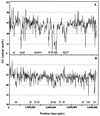Complete genome sequence of the alkaliphilic bacterium Bacillus halodurans and genomic sequence comparison with Bacillus subtilis
- PMID: 11058132
- PMCID: PMC113120
- DOI: 10.1093/nar/28.21.4317
Complete genome sequence of the alkaliphilic bacterium Bacillus halodurans and genomic sequence comparison with Bacillus subtilis
Abstract
The 4 202 353 bp genome of the alkaliphilic bacterium Bacillus halodurans C-125 contains 4066 predicted protein coding sequences (CDSs), 2141 (52.7%) of which have functional assignments, 1182 (29%) of which are conserved CDSs with unknown function and 743 (18. 3%) of which have no match to any protein database. Among the total CDSs, 8.8% match sequences of proteins found only in Bacillus subtilis and 66.7% are widely conserved in comparison with the proteins of various organisms, including B.subtilis. The B. halodurans genome contains 112 transposase genes, indicating that transposases have played an important evolutionary role in horizontal gene transfer and also in internal genetic rearrangement in the genome. Strain C-125 lacks some of the necessary genes for competence, such as comS, srfA and rapC, supporting the fact that competence has not been demonstrated experimentally in C-125. There is no paralog of tupA, encoding teichuronopeptide, which contributes to alkaliphily, in the C-125 genome and an ortholog of tupA cannot be found in the B.subtilis genome. Out of 11 sigma factors which belong to the extracytoplasmic function family, 10 are unique to B. halodurans, suggesting that they may have a role in the special mechanism of adaptation to an alkaline environment.
Figures











Similar articles
-
Regulation of the tryptophan biosynthetic genes in Bacillus halodurans: common elements but different strategies than those used by Bacillus subtilis.J Bacteriol. 2004 Feb;186(3):818-28. doi: 10.1128/JB.186.3.818-828.2004. J Bacteriol. 2004. PMID: 14729709 Free PMC article.
-
Analysis of the genome of an alkaliphilic Bacillus strain from an industrial point of view.Extremophiles. 2000 Apr;4(2):99-108. doi: 10.1007/s007920050143. Extremophiles. 2000. PMID: 10805564 Review.
-
Complete genome sequence of the industrial bacterium Bacillus licheniformis and comparisons with closely related Bacillus species.Genome Biol. 2004;5(10):R77. doi: 10.1186/gb-2004-5-10-r77. Epub 2004 Sep 13. Genome Biol. 2004. PMID: 15461803 Free PMC article.
-
The complete genome sequence of Bacillus licheniformis DSM13, an organism with great industrial potential.J Mol Microbiol Biotechnol. 2004;7(4):204-11. doi: 10.1159/000079829. J Mol Microbiol Biotechnol. 2004. PMID: 15383718
-
The Na+/H+ antiporter of alkaliphilic Bacillus sp.Extremophiles. 2000 Oct;4(5):253-8. doi: 10.1007/s007920070010. Extremophiles. 2000. PMID: 11057908 Review.
Cited by
-
Characterization of the metal ion binding site in the anti-terminator protein, HutP, of Bacillus subtilis.Nucleic Acids Res. 2005 Sep 28;33(17):5494-502. doi: 10.1093/nar/gki868. Print 2005. Nucleic Acids Res. 2005. PMID: 16192572 Free PMC article.
-
The genome of BCJA1c: a bacteriophage active against the alkaliphilic bacterium, Bacillus clarkii.Extremophiles. 2005 Apr;9(2):99-109. doi: 10.1007/s00792-004-0425-0. Epub 2004 Nov 17. Extremophiles. 2005. PMID: 15841342
-
The program of gene transcription for a single differentiating cell type during sporulation in Bacillus subtilis.PLoS Biol. 2004 Oct;2(10):e328. doi: 10.1371/journal.pbio.0020328. Epub 2004 Sep 21. PLoS Biol. 2004. PMID: 15383836 Free PMC article.
-
An expression-driven approach to the prediction of carbohydrate transport and utilization regulons in the hyperthermophilic bacterium Thermotoga maritima.J Bacteriol. 2005 Nov;187(21):7267-82. doi: 10.1128/JB.187.21.7267-7282.2005. J Bacteriol. 2005. PMID: 16237010 Free PMC article.
-
Cloning, sequence analysis, and expression in Escherichia coli of the gene encoding an alpha-amino acid ester hydrolase from Acetobacter turbidans.Appl Environ Microbiol. 2002 Jan;68(1):211-8. doi: 10.1128/AEM.68.1.211-218.2002. Appl Environ Microbiol. 2002. PMID: 11772629 Free PMC article.
References
-
- Ikura Y. and Horikoshi,K. (1979) Agric. Biol. Chem., 43, 85–88.
-
- Honda H., Kudo,T., Ikura,Y. and Horikoshi,K. (1985) Can. J. Microbiol., 31, 538–542.
-
- Takami H. and Horikoshi,K. (1999) Biosci. Biotechnol. Biochem., 63, 943–945. - PubMed
-
- Kunst F., Ogasawara,N., Moszer,I., Albertini,A.M., Alloni,G., Azevedo,V., Bertero,M.G., Bessieres,P., Bolotin,A., Borchert,S. et al. (1997) Nature, 390, 249–256. - PubMed
Publication types
MeSH terms
Substances
LinkOut - more resources
Full Text Sources
Other Literature Sources
Molecular Biology Databases

